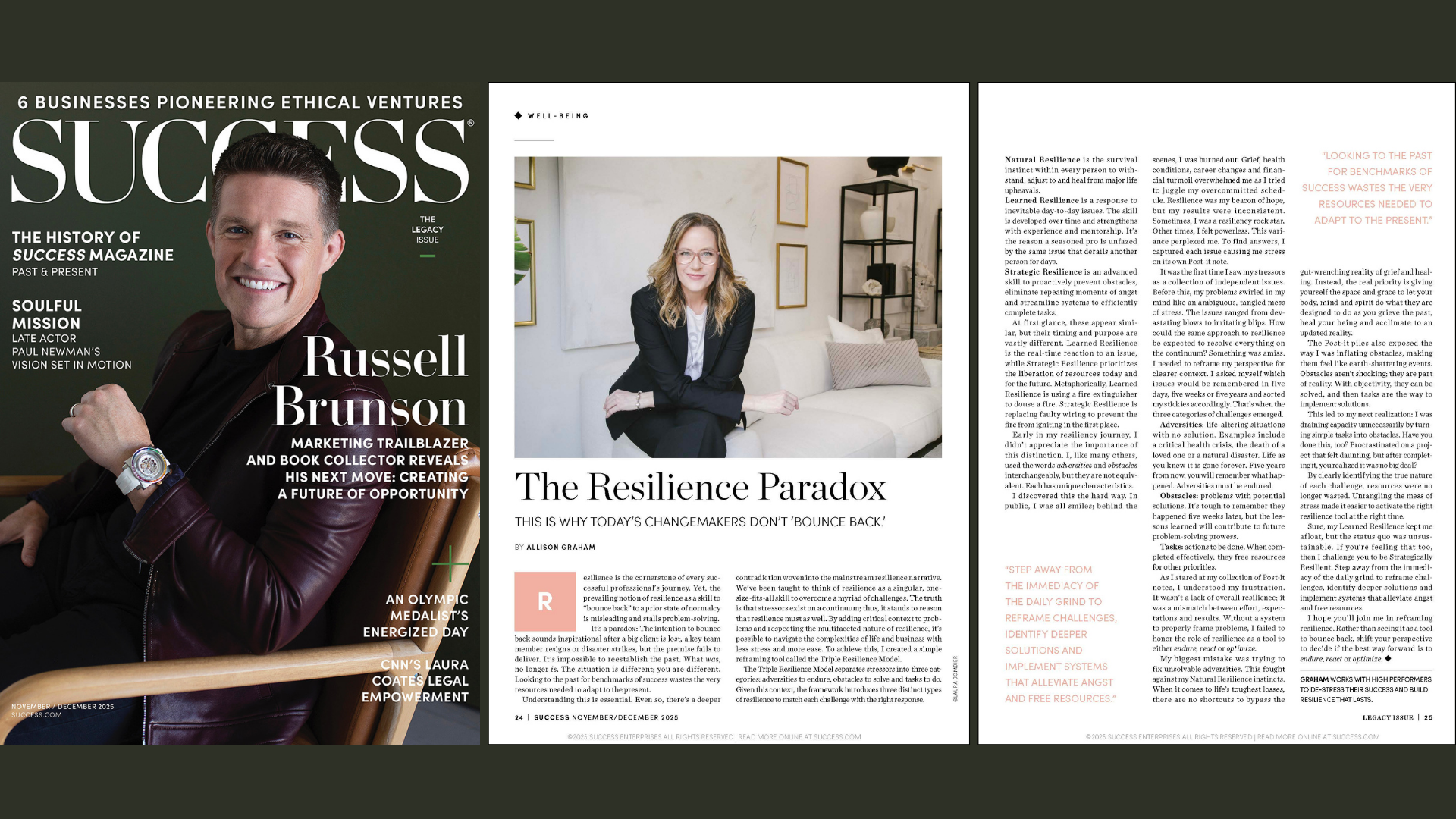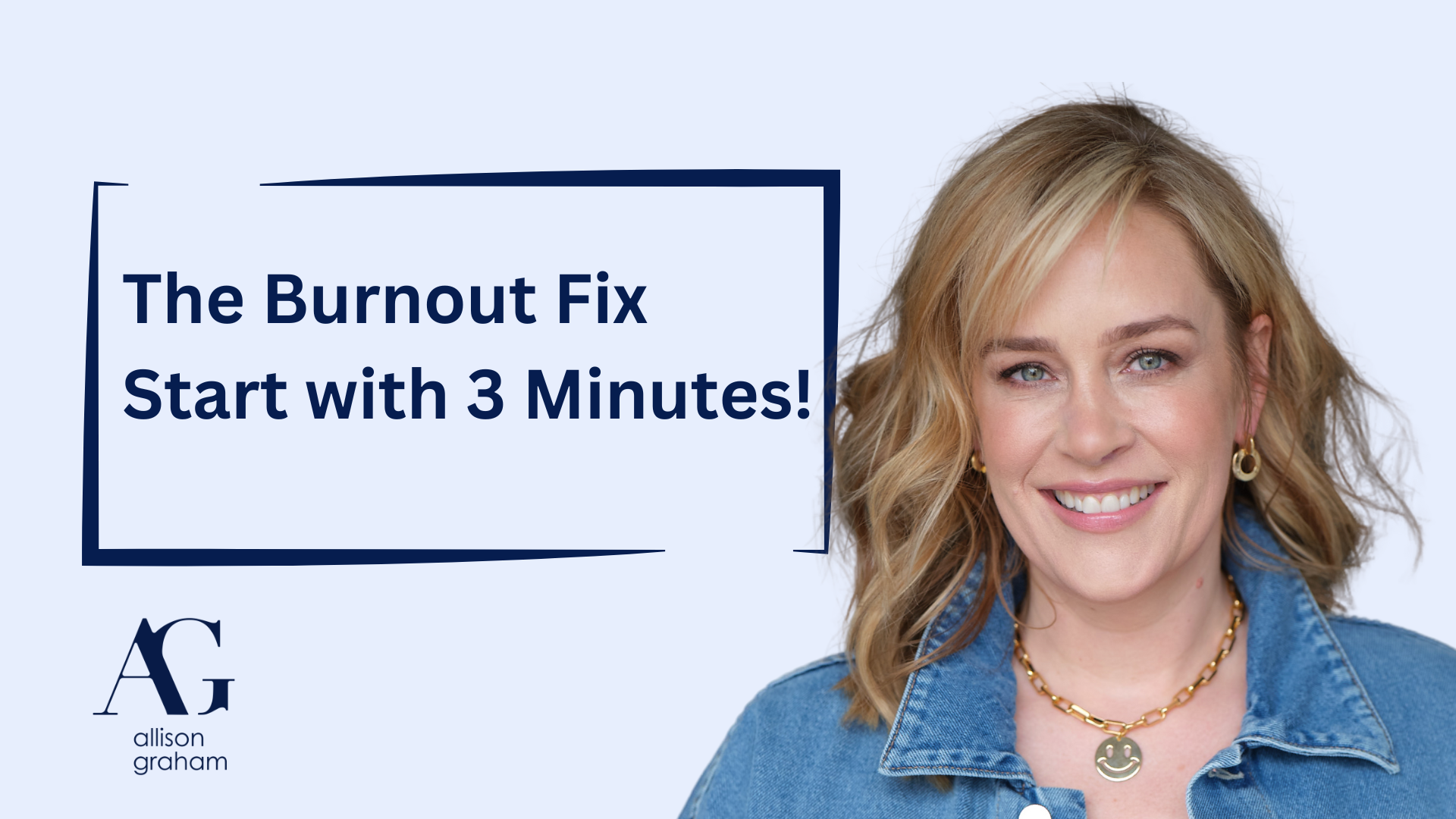Why Today’s Change Makers Don’t ‘Bounce Back’
BY ALLISON GRAHAM (originally published in Success Magazine, Legacy Issue Nov/Dec 2025
Resilience is the cornerstone of every successful professional’s journey. Yet, the prevailing notion of resilience as a skill to “bounce back” to a prior state of normalcy is misleading and stalls problem-solving.
It’s a paradox: The intention to bounce back sounds inspirational after a big client is lost, a key team member resigns or disaster strikes, but the premise fails to deliver. It’s impossible to reestablish the past. What was, no longer is. The situation is different; you are different. Looking to the past for benchmarks of success wastes the very resources needed to adapt to the present.
Understanding this is essential. Even so, there’s a deeper contradiction woven into the mainstream resilience narrative. We’ve been taught to think of resilience as a singular, one- size-fits-all skill to overcome a myriad of challenges. The truth is that stressors exist on a continuum; thus, it stands to reason that resilience must as well. By adding critical context to problems and respecting the multifaceted nature of resilience, it’s possible to navigate the complexities of life and business with less stress and more ease. To achieve this, I created a simple reframing tool called the Triple Resilience Model.
Natural Resilience is the survival instinct within every person to withstand, adjust to and heal from major life upheavals.
Learned Resilience is a response to inevitable day-to-day issues. The skill is developed over time and strengthens with experience and mentorship. It’s the reason a seasoned pro is unfazed by the same issue that derails another person for days.
Strategic Resilience is an advanced skill to proactively prevent obstacles, eliminate repeating moments of angst and streamline systems to efficiently complete tasks.
At first glance, these appear similar, but their timing and purpose are vastly different. Learned Resilience is the real-time reaction to an issue, while Strategic Resilience prioritizes the liberation of resources today and for the future. Metaphorically, Learned Resilience is using a fire extinguisher to douse a fire. Strategic Resilience is replacing faulty wiring to prevent the fire from igniting in the first place.
Early in my resiliency journey, I didn’t appreciate the importance of this distinction. I, like many others, used the words adversities and obstacles interchangeably, but they are not equivalent. Each has unique characteristics.
I discovered this the hard way. In public, I was all smiles; behind the scenes, I was burned out. Grief, health conditions, career changes and financial turmoil overwhelmed me as I tried to juggle my overcommitted schedule.
Resilience was my beacon of hope, but my results were inconsistent. Sometimes, I was a resiliency rock star. Other times, I felt powerless. This variance perplexed me. To find answers, I captured each issue causing me stress on its own Post-it note.
It was the first time I saw my stressors as a collection of independent issues. Before this, my problems swirled in my mind like an ambiguous, tangled mess of stress. The issues ranged from devastating blows to irritating blips. How could the same approach to resilience be expected to resolve everything on the continuum? Something was amiss. I needed to reframe my perspective for clearer context. I asked myself which issues would be remembered in five days, five weeks or five years and sorted my stickies accordingly. That’s when the three categories of challenges emerged.
Adversities: life-altering situations with no solution. Examples include a critical health crisis, the death of a loved one or a natural disaster. Life as you knew it is gone forever. Five years from now, you will remember what happened. Adversities must be endured.
Obstacles: problems with potential solutions. It’s tough to remember they happened five weeks later, but the les- sons learned will contribute to future problem-solving prowess.
Tasks: actions to be done. When completed effectively, they free resources for other priorities.
As I stared at my collection of Post-it notes, I understood my frustration. It wasn’t a lack of overall resilience; it was a mismatch between effort, expectations and results. Without a system to properly frame problems, I failed to honor the role of resilience as a tool to either endure, react or optimize.
My biggest mistake was trying to fix unsolvable adversities. This fought against my Natural Resilience instincts. When it comes to life’s toughest losses, there are no shortcuts to bypass the gut-wrenching reality of grief and healing. Instead, the real priority is giving yourself the space and grace to let your body, mind and spirit do what they are designed to do as you grieve the past, heal your being and acclimate to an updated reality.
The Post-it piles also exposed the way I was inflating obstacles, making them feel like earth-shattering events. Obstacles aren’t shocking; they are part of reality. With objectivity, they can be solved, and then tasks are the way to implement solutions.
This led to my next realization: I was draining capacity unnecessarily by turning simple tasks into obstacles. Have you done this, too? Procrastinated on a project that felt daunting, but after completing it, you realized it was no big deal?
By clearly identifying the true nature of each challenge, resources were no longer wasted. Untangling the mess of stress made it easier to activate the right resilience tool at the right time.
Sure, my Learned Resilience kept me afloat, but the status quo was unsustainable. If you’re feeling that too, then I challenge you to be Strategically Resilient. Step away from the immediacy of the daily grind to reframe challenges, identify deeper solutions and implement systems that alleviate angst and free resources.
I hope you’ll join me in reframing resilience. Rather than seeing it as a tool to bounce back, shift your perspective to decide if the best way forward is to endure, react or optimize. ◆








